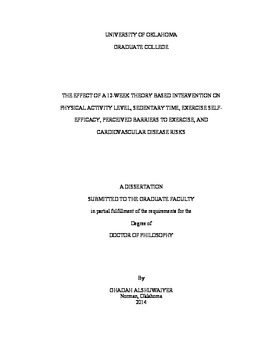| dc.description.abstract | Purpose: The study assessed the impact of a 12-week walking intervention on physical activity (PA) level, sedentary time (ST), and cardiovascular disease (CVD) risks among inactive adults with dyslipidemia. Methods: Faculty and staff at the University of Oklahoma (age=40-64 years) were randomly assigned to either a Walking-Plus (WP) or Walking-Only (WO) group. Both groups engaged in progressive walking (50-60% of maximum heart rate) for 30 to 60 min/day over 12 weeks. All participants were given pedometers and asked to record steps/day. They were encouraged to accumulate at least 10,000 steps/day. In addition, the WP group was instructed to interrupt sedentary time (ST) every 30 minutes for ≥2 minutes. Lipid profiles, PA, and ST were measured at pre- and post-intervention, and at 3-month follow-up. PA and ST were also assessed at week 6 of the intervention. Results: 21 participants began the study with 15 subjects completing all testing sessions (WP=7; WO=8). Daily step count (F (3,36)=16.91, p= 0.00) and moderate-vigorous intensity PA (F (3,39)=10.98, p= 0.00) improved over time in both groups. LDL-C (F (2,24)=3.63, p=0.042) and total cholesterol [F (2,26)=3.636, p=0.041) levels increased over time in both groups, which was opposite of the predicted effect. HDL-C significantly improved over time (F (2,26)=6.273, p=0.006) and between groups (F (1, 13)=9.39, p=0.009), but no significant time X group interaction (F (2,26)=0.319, p=0.729) was observed. The WP group had higher mean levels for HDL-C (51.6±12.1) at baseline compared to WO (40.6± 5.9) group. Conclusion: PA and HDL-C improved in both groups, as expected. However, no between group differences were found in ST or clinical outcomes. This could be due to small sample size, variation in blood collection methods, or the impact of weather changes on activity level. Low compliance with the program was also observed. The WP group reported that tracking sedentary breaks was difficult and frustrating, and the experience discouraged them from participation in walking as well as in attempts to increase breaks in sedentary time. | en_US |
